1996 CADILLAC FLEETWOOD light
[x] Cancel search: lightPage 230 of 306
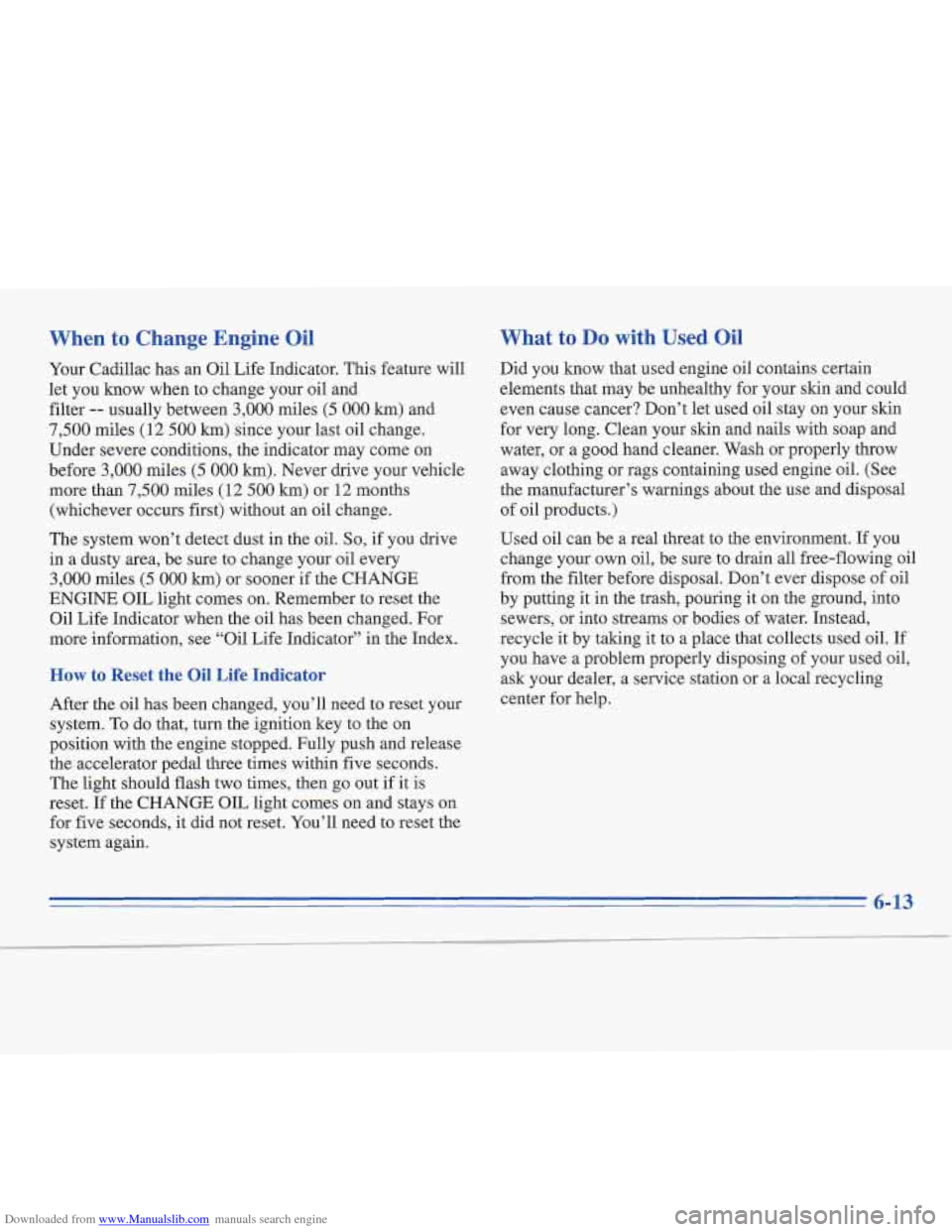
Downloaded from www.Manualslib.com manuals search engine When to Change Engine Oil
Your Cadillac has an Oil Life Indicator. This feature will
let you know when to change your oil and
filter
-- usually between 3,000 miles (5 000 km) and
7,500 miles (12 500 km) since your last oil change.
Under severe conditions, the indicator may come on
before
3,000 miles (5 000 km). Never drive your vehicle
more than
7,500 miles (12 500 km) or 12 months
(whichever occurs first) without an oil change.
The system won’t detect dust in the oil.
So, if you drive
in a dusty area, be sure to change your oil every
3,000 miles (5 000 krn) or sooner if the CHANGE
ENGINE
OIL light comes on. Remember to reset the
Oil Life Indicator when the oil has been changed. For
more information, see “Oil Life Indicator” in the Index.
How to Reset the Oil Life Indicator
After the oil has been changed, you’ll need to reset your
system. To do that, turn the ignition key to the on
position with the engine stopped. Fully push and release
the accelerator pedal
three times within five seconds.
The light should flash two times, then go out if
it is
reset.
If the CHANGE OIL light comes on and stays on
for five seconds,
it did not reset. You:’Uneed to reset the
system again.
What to Do witL Used Oil
Did you know that used engine oil contains certain
elements that may be unhealthy for your skin and could
even cause cancer? Don’t let used oil stay on your skin
for very long. Clean your skin and nails with soap and
water, or a good hand cleaner. Wash or properly throw
away clothing
or rags containing used engine oil. (See
the manufacturer’s warnings about the use and disposal
of oil products.)
Used oil can be a real threat to the environment. If you
change your own oil, be sure to drain all free-flowing oil
from the filter before disposal. Don’t ever dispose of oil
by putting it in the trash, pouring it on the ground, into
sewers, or into streams or bodies of water. Instead,
recycle it by taking
it to a place that collects used oil, If
you have
a problem properly disposing of your used oil,
ask your dealer, a service station or a local recycling
center for help.
Page 237 of 306

Downloaded from www.Manualslib.com manuals search engine Engine Coolant
The cooling system in your vehicle is filled with new
DEX-COOL
TM (orange-colored, silicate-free) engine
coolant.
This coolant is designed to remain in your
vehicle for
5 years or 100,000 miles (166 000 km),
whichever occurs first.
The following explains your cooling system and how to
add coolant when it is low. If you have a problem with
engine overheating, see “Engine Overheating” in
the Index.
A 50/50 mixture of water and the proper coolant for
your Cadillac will:
0
0
0
0
0
Give freezing protection down to -34°F (-37°C).
Give boiling protection up to 265
” F ( 129 O C).
Protect against rust and corrosion.
Help keep the proper engine temperature.
Let the warning lights and gages work as
they should.
6-20
Page 239 of 306
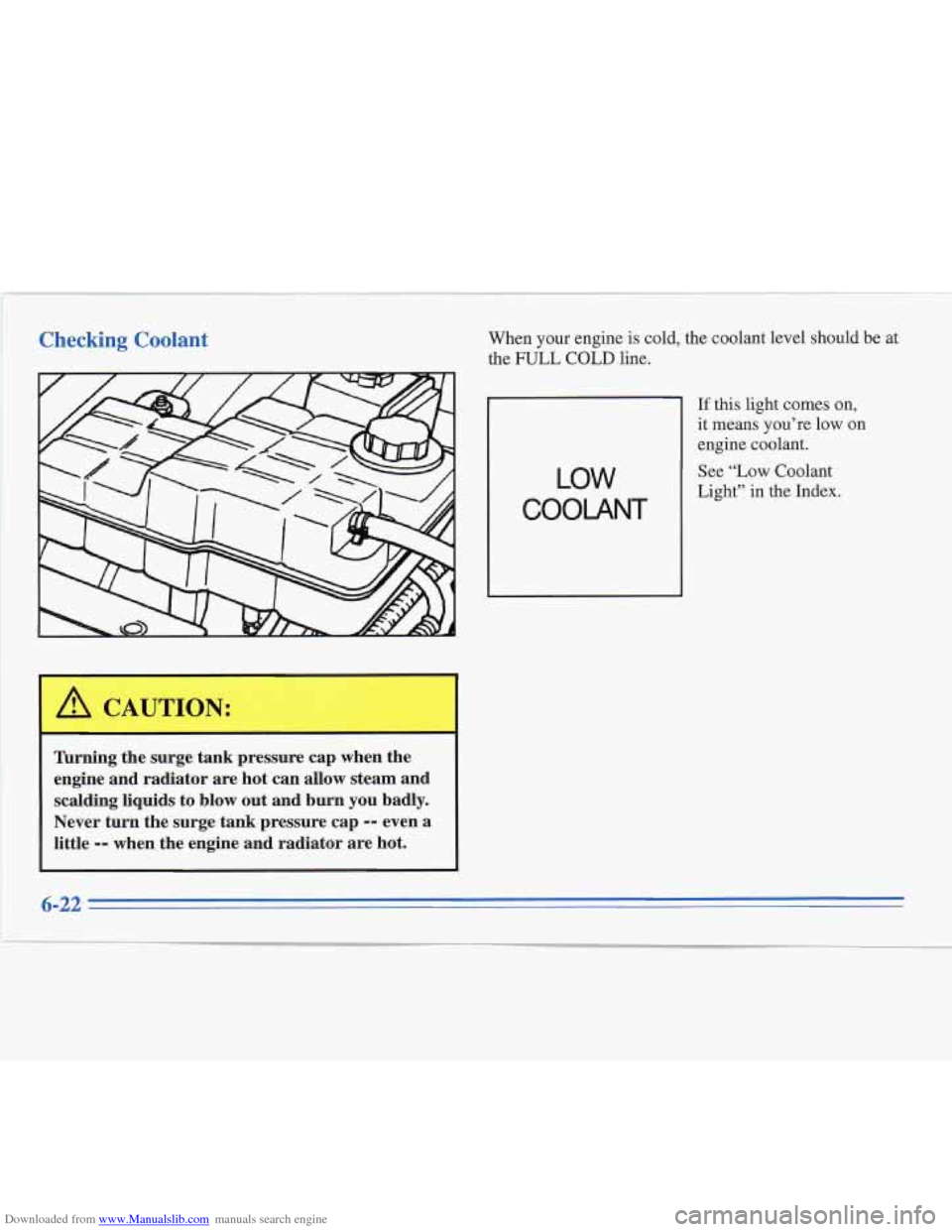
Downloaded from www.Manualslib.com manuals search engine :: ’ 1 ,-
Checking Coolant
Turning the surge t engine and radiator are hot can allow steam and
scalding liquids to blow out and burn you badly.
Never turn the surge tank pressure cap
-- even a
little
-- when the engine and radiator are hot.
LOW
COOLANT
J
If this light comes on,
it means you’re low on
engine coolant.
See “Low Coolant
Light” in the Index.
6-22
Page 246 of 306
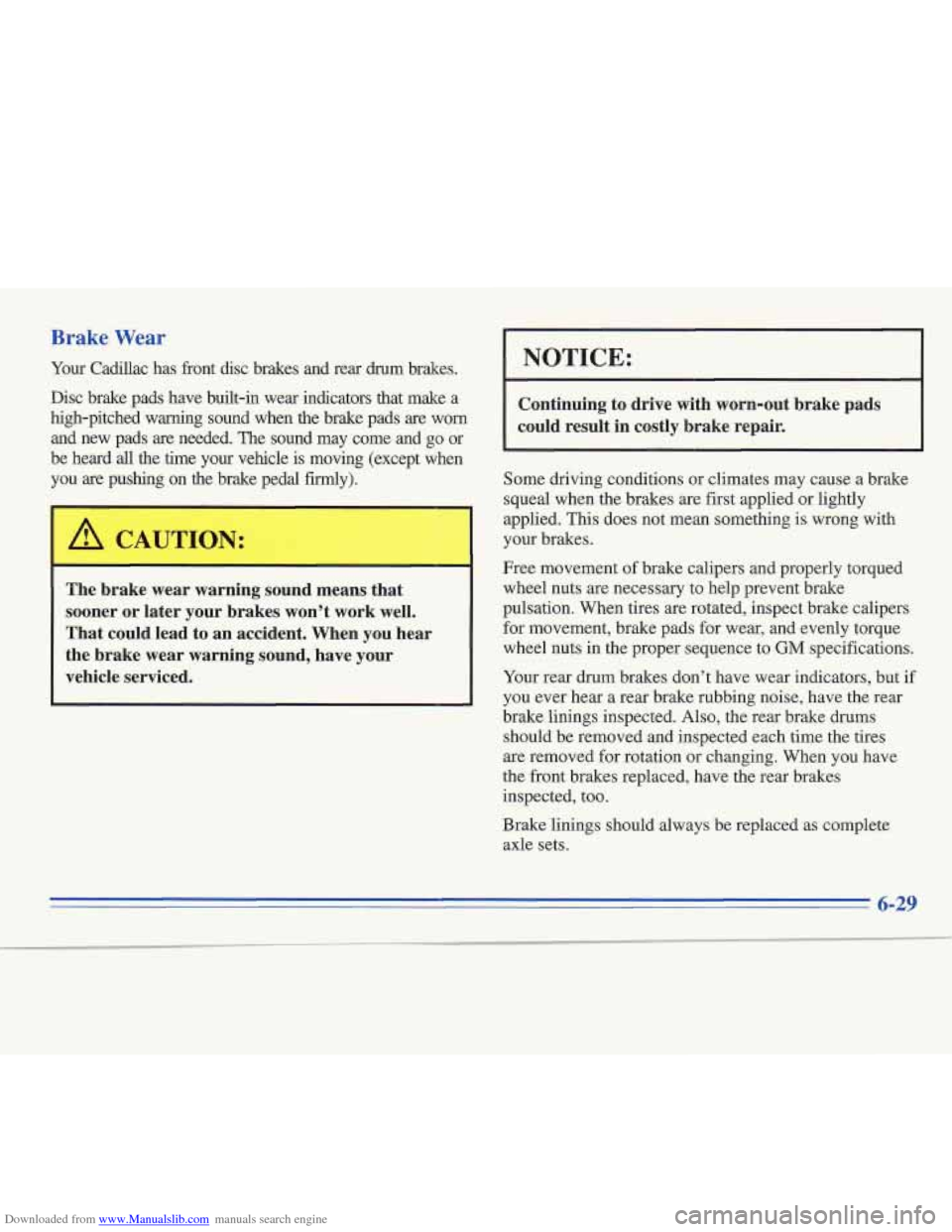
Downloaded from www.Manualslib.com manuals search engine Brake Wear
Your Cadillac has fiont disc brakes and rear drum brakes.
Disc brake pads have built-in wear indicators that make a
high-pitched warning sound when
the brake pads are worn
and new pads
are needed. The sound may come and go or
be heard
all the time your vehicle is moving (except when
you are pushing on the brake pedal firrnly).
I A CAUTION:
The brake wear warning sound means that
sooner or later your brakes won’t work well.
That could lead to an accident. When you hear
the brake wear warning sound, have your
vehicle serviced.
I NOTICE:
Continuing to drive with worn-out brake pads
could result in costly brake repair.
Some driving conditions or climates may cause a brake
squeal when the brakes
are first applied or lightly
applied. This does not mean something is wrong with
your brakes.
Free movement of brake calipers and properly torqued
wheel nuts are necessary to help prevent brake
pulsation. When tires are rotated, inspect brake calipers
for movement, brake pads for wear, and evenly torque
wheel nuts
in the proper sequence to GM specifications.
Your rear drum brakes don’t have wear indicators, but if
you ever hear a rear brake rubbing noise, have the rear
brake linings inspected. Also, the rear brake drums
should be removed and inspected each time the tires
are removed for rotation or changing. When you have
the front brakes replaced, have the rear brakes
inspected, too.
Brake linings should always be replaced as complete
axle sets.
6-29
~~
Page 261 of 306
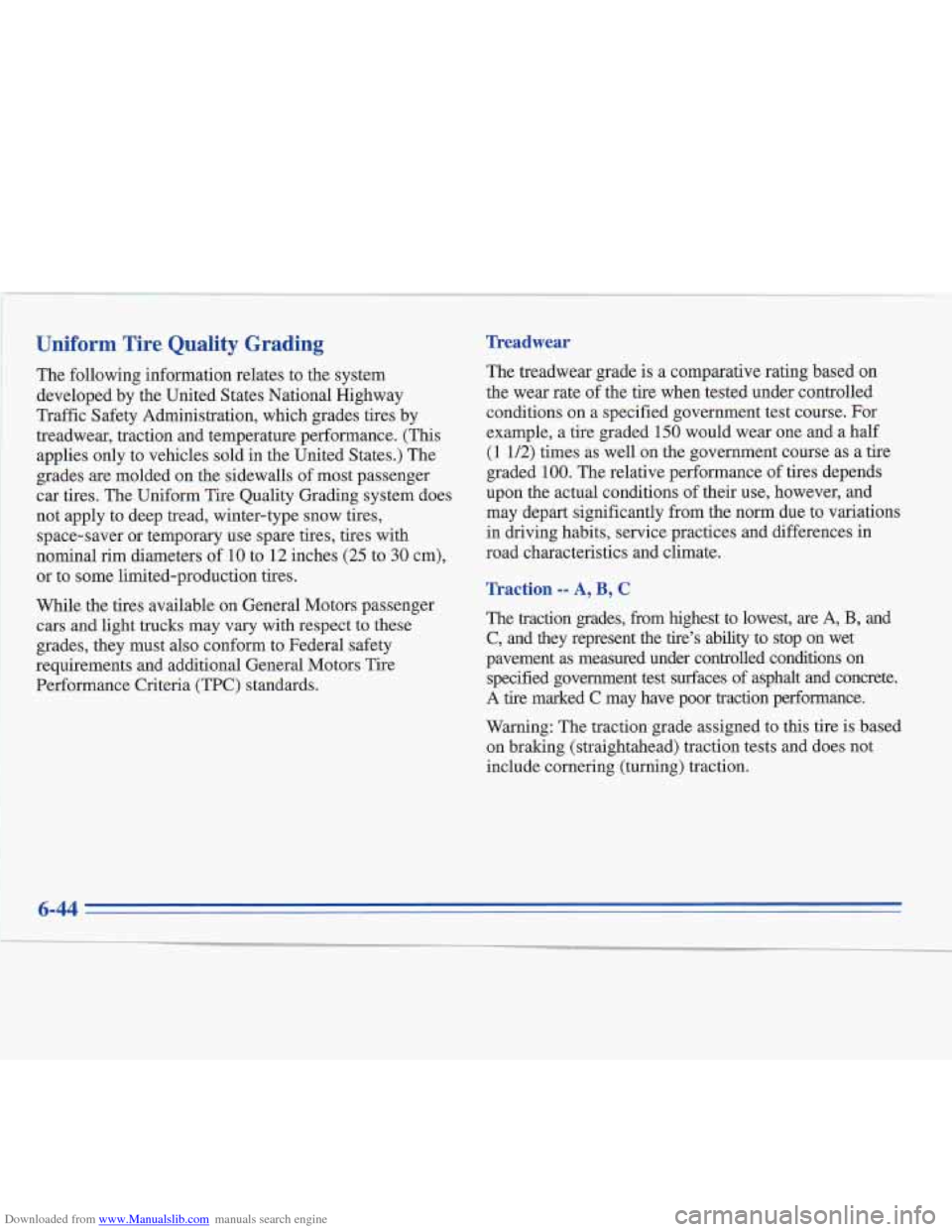
Downloaded from www.Manualslib.com manuals search engine Uniform Tire Quality Grading
The following information relates to the system
developed by the United States National Highway
Traffic Safety Administration, which grades tires by
treadwear, traction and temperature performance. (This applies only to vehicles sold in the United States.) The
grades are molded on the sidewalls
of most passenger
car tires. The Uniform Tire Quality Grading system does
not apply to deep tread, winter-type snow tires,
space-saver or temporary use spare tires, tires with
nominal rim diameters of
10 to 12 inches (25 to 30 cm),
or to some limited-production tires.
While the tires available on General Motors passenger
cars and light trucks may vary with respect to these
grades, they must also conform to Federal safety
requirements and additional General Motors Tire
Performance Criteria (TPC) standards.
Treadwear
The treadwear grade is a comparative rating based on
the wear rate
of the tire when tested under controlled
conditions on a specified government test course. For
example, a tire graded 150 would wear one and a half
(1 1/2) times as well on the government course as a tire
graded 100. The relative performance of tires depends
upon the actual conditions
of their use, however, and
may depart significantly from the norm due to variations
in driving habits, service practices and differences in
road characteristics and climate.
Traction -- A, B, C
The traction grades, kom highest to lowest, are A, B, and
C, and they represent the tire’s ability to stop on wet
pavement as measured under controlled conditions on specified government test surfaces of asphalt and concrete.
A
tire marked C may have poor traction performance.
Warning: The traction grade assigned to this tire is based
on braking (straightahead) traction tests and does not
include cornering (turning) traction.
Page 266 of 306
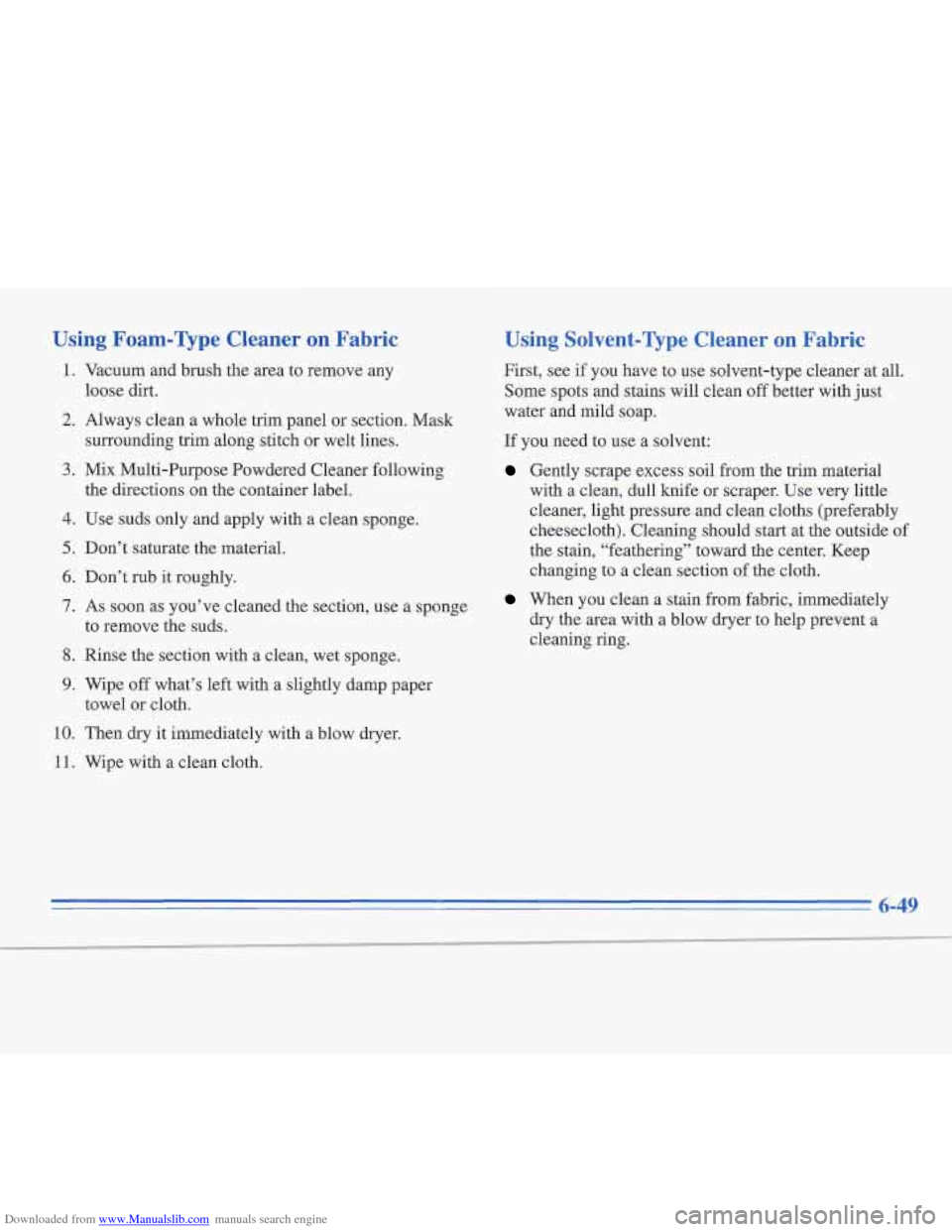
Downloaded from www.Manualslib.com manuals search engine Using Foam-Type Cleaner on Fabric
1. Vacuum and brush the area to remove any
2. Always clean a whole trim panel or section. Mask
3. Mix Multi-Purpose Powdered Cleaner following
loose dirt.
surrounding trim along stitch or welt lines.
the directions on the container label.
4. Use suds only and apply with a clean sponge.
5. Don’t saturate the material.
6. Don’t rub it roughly.
7. As soon as you’ve cleaned the section, use a sponge
8. Rinse the section with a clean, wet sponge.
to
remove the suds.
9. Wipe off what’s left with a slightly damp paper
towel or cloth.
10. Then dry it immediately with a blow dryer.
11. Wipe with a clean cloth.
Using Solvent-Type Cleaner on Fabric
First, see if you have to use solvent-type cleaner at all.
Some spots and stains will clean
off better with just
water and mild soap.
If you need to use
a solvent:
Gently scrape exc-ess-soil from the trim material
with a clean, dull knife
or scraper. Use very little
cleaner, light pressure and clean cloths (preferably
cheesecloth). Cleaning should start at the outside of
the stain, “feathering” toward the center. Keep
changing to a clean section
of the cloth.
When you clean a stain from fabric, immediately
dry the area with a blow dryer to help prevent a
cleaning ring.
Page 267 of 306
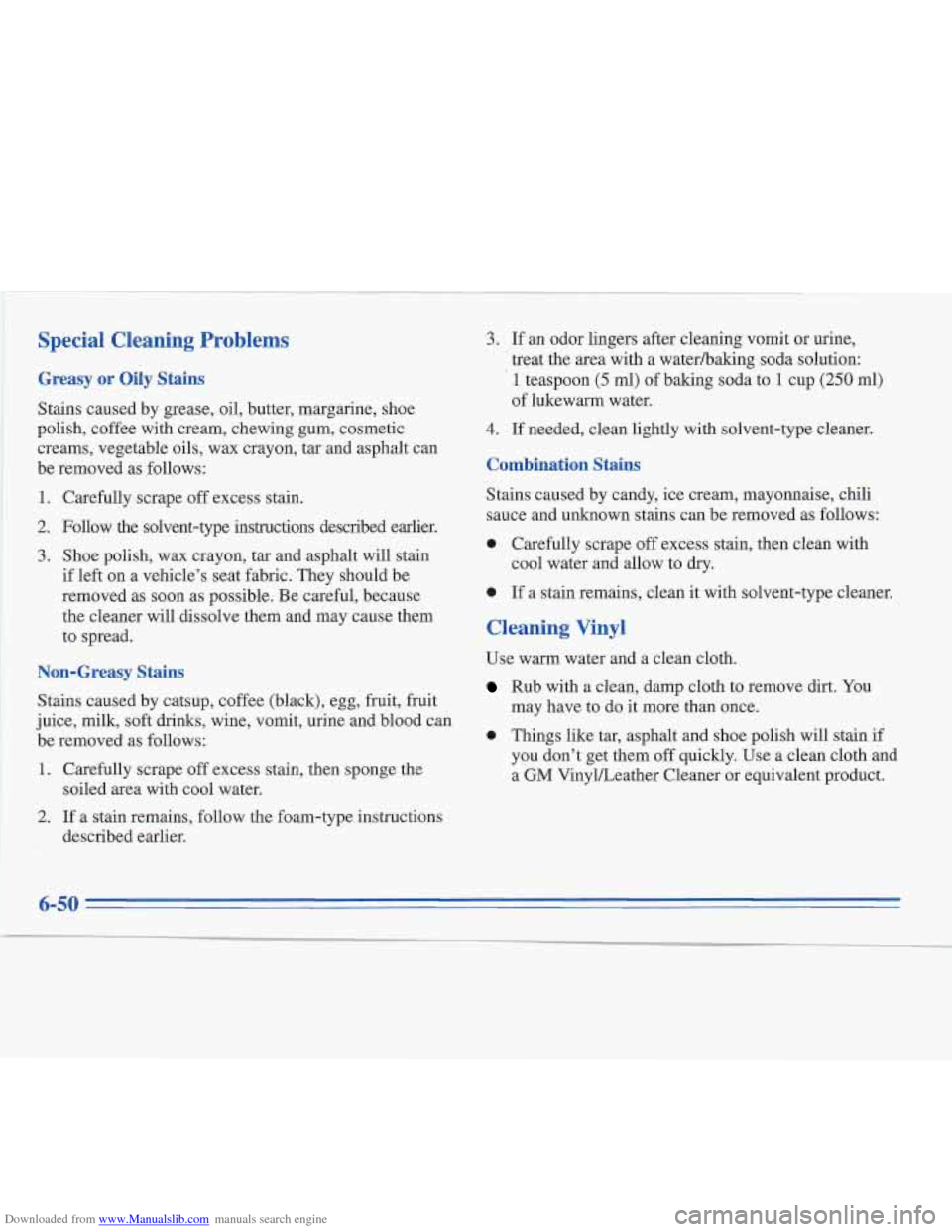
Downloaded from www.Manualslib.com manuals search engine Special Cleaning Problems
Greasy or Oily Stains
Stains caused by grease, oil, butter, margarine, shoe
polish, coffee with cream, chewing gum, cosmetic
creams, vegetable oils, wax crayon, tar and asphalt can
be removed as follows:
1. Carefully scrape off excess stain.
2. Follow the solvent-type instructions described earlier.
3. Shoe polish, wax crayon, tar and asphalt will stain
if left on a vehicle’s seat fabric. They should be
removed as soon as possible. Be careful, because
the cleaner will dissolve them and may cause them
to spread.
3. If an odor lingers after cleaning vomit or urine,
treat the area with a waterhaking soda solution:
1 teaspoon (5 ml) of baking soda to 1 cup (250 ml)
of lukewarm water.
4. If needed, clean lightly with solvent-type cleaner.
Combination Stains
Stains caused by candy, ice cream, mayonnaise, chili
sauce and unknown stains can be removed as follows:
0 Carefully scrape off excess stain, then clean with
cool water and allow to
dry.
0 If a stain remains, clean it with solvent-type cleaner.
Cleaning Vinyl
Use warm water and a clean cloth.
Rub with a clean, damp cloth to remove dirt. You
Non-Greasy Stains
Stains caused by catsup, coffee (black), egg, fruit, fruit may have to do it more than once.
juice,
milk, soft drinks, wine, vomit, urine and blood can
be removed as follows:
0 Things like tar, asphalt and shoe polish will stain if
1. Carefully scrape off excess stain, then sponge the a GM VinyVLeather Cleaner or equivalent product.
2. If a stain remains, follow the foam-type instructions you
don’t get them
off quickly. Use a clean cloth and
soiled area with cool water.
described earlier.
6-50
Page 275 of 306
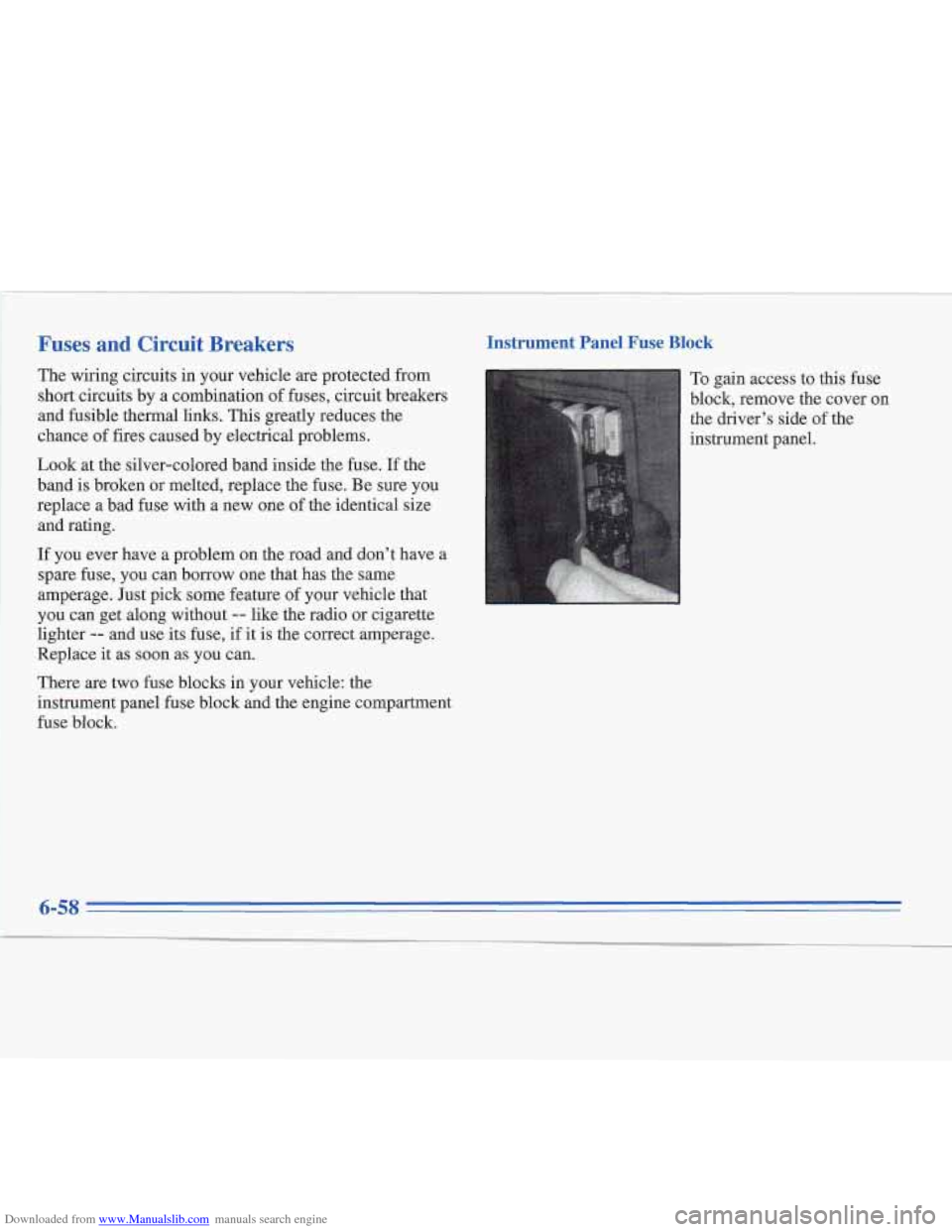
Downloaded from www.Manualslib.com manuals search engine Fuses and Circuit Breakers
The wiring circuits in your vehicle are protected from
short circuits by a combination of fuses, circuit breakers
and fusible thermal
links. This greatly reduces the
chance of fires caused by electrical problems.
Look at the silver-colored band inside the fuse. If the
band is broken or melted, replace the fuse. Be sure you
replace a bad fuse with a new one of the identical size
and rating.
li you ever have a problem on the road and don’t have a
spare fuse, you can borrow one that has the same
amperage. Just pick some feature
of your vehicle that
you can get along without
-- like the radio or cigarette
lighter
-- and use its fuse, if it is the correct amperage.
Replace it as soon as you can.
There are two fuse blocks in your vehicle: the
instrument panel fuse block and the engine compartment fuse block.
Instrument Panel Fuse Bloc
To gain access to this fuse
block, remove the cover on the driver’s side of the
instrument panel.